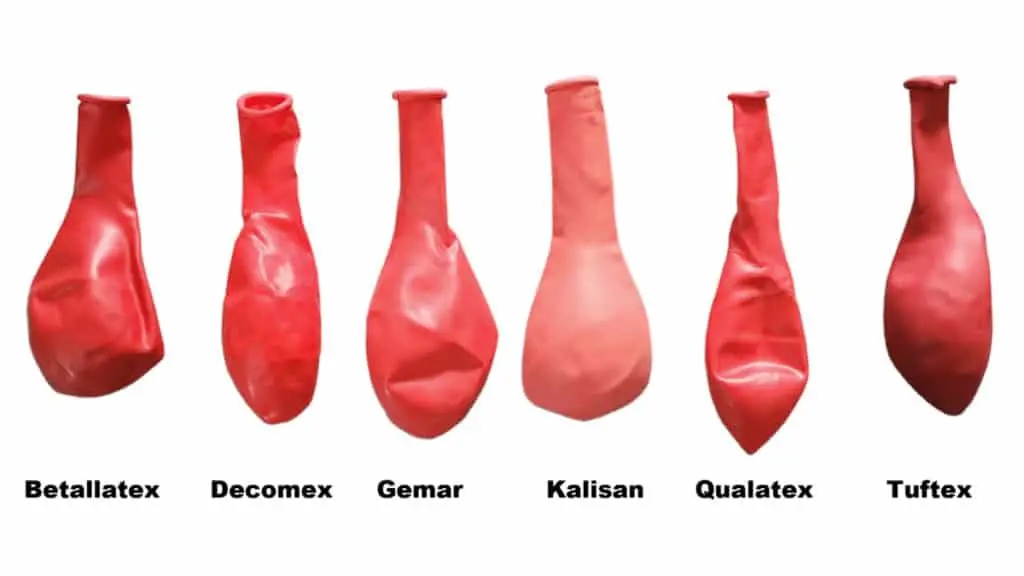This post contains affiliate links.

Latex balloons come in many different shapes, sizes, and colors. They are even made by many different manufacturers and brands. Despite their seemingly endless selection to choose from, they all have the same basic parts. In this post, we are going to look at the several different parts of a latex balloon, the anatomy of a balloon if you will.
Parts Of A Latex Balloon
The parts of a balloon are the body, the neck, the lip, the drip point, and the body to neck transition. After the balloon is tied it will also have the knot, located in the neck of the balloon.
Body
The body of a latex balloon is the round part that is made to be inflated. It is the spherical, elliptical, or bulb shaped part of the balloon depending on the type and shape of the balloon you are referring to. The body of the balloon is also sometimes called the belly of the balloon. The body of the balloon is the part of the balloon that most people find the most enjoyable. It is the part that is inflated with air or helium. The body of the balloon expands as it is filled with air or helium.
A balloon is considered to be fully inflated when the body of the balloon reaches the size of the intended balloon. Check out my post Best Way To Size A Balloon – Balloon Sizer here for more information on how to properly size a balloon.
Neck
The neck of a latex balloon is the long skinny part of the balloon that connects the lip of the balloon to the body of the balloon. The neck of the balloon is also sometimes called the stem of the balloon. The neck of the balloon is also used for tying the balloon so it won’t deflate.
The length of a balloon’s neck may differ from manufacturer to manufacturer. Some manufacturers claim a longer neck can make the balloon easier to tie. The neck of the balloon should not be inflated. Check out my post How To Tie A Balloon or Tie A Balloon Easy With A Balloon Tie Tool – Painless for more information on properly tying a balloon.

Here are the top six balloon brands as polled by balloon professionals, you can see especially well with each of the balloons lined up next to one another that they indeed have different neck lengths but they all have the same basic parts. Check out my post on Balloon Brands here for a more in-depth look at the top balloon brands.
Lip

The lip of the balloon is the rolled-down part of a latex balloon that you inflate the balloon with. The lip of the balloon is sometimes called the bead of the balloon. You can either use air or helium to inflate your balloon. It used to be common practice to inflate a balloon with your mouth (it is no longer an acceptable practice) however maybe that’s where the name lip came from. I prefer to inflate my balloons with a hand pump (when inflating just a few balloons), here you can find my favorite hand pump on Amazon for around $12 when writing this post.
Although inflating balloons with your mouth used to be common practice, you should never inflate a balloon with your mouth, check out my post Never Inflate A Balloon With Your Mouth – 5 Reasons.
Drip Point

The drip point of the balloon is the part of the balloon that the latex mixture dripped from during the making process. The drip point of the balloon is sometimes called the nipple of the balloon.

While making a latex balloon, a mold is dipped in a latex mixture, and the excess is allowed to drip off the mold, forming the drip point.

Here are the top six balloon brands again, if you look closely you can see how each of the different manufacturer brands have different looking drip points. Some brands have thick or dark drip points and some brands have lighter or barely even visible drip points. Check out my post on Balloon Brands for a more in-depth look at the top balloon brands.
Body To Neck Transition

The body to neck transition of the balloon is the small part of the balloon that transitions from the long skinny neck to the elliptical or round body area of the balloon. If you have ever overinflated a balloon, you may have noticed the neck transition starting to inflate.

Here are the top six balloon brands one last time, this time let’s look at how each brand has a slightly different body to neck transition. Check out my post on Balloon Brands here for a more in-depth look at the top balloon brands.
Knot
The knot of the balloon is not actually part of the balloon itself but rather created after inflation to secure the balloon from deflating. A knot is tied in the neck of the balloon. Check out my post How To Tie A Balloon or Tie A Balloon Easy With A Balloon Tie Tool – Painless for more information on how to properly tie a balloon. I also have a video, Three Ways To Tie A Balloon check it out below.
Some other posts you might be interested are Where To Buy High Quality Balloons, How To Untie A Balloon – Three Ways To Untie A Balloon, How To Pop A Balloon – Quietly, Without Touching, And Do They Hurt, and All About Mosaic Balloon Kits: What They Are, Where To Get Them, And More.
I hope this post brought value to your day. If it did, please consider sharing with a friend or on your favorite social media. Thanks For Reading Fun With Balloons!

